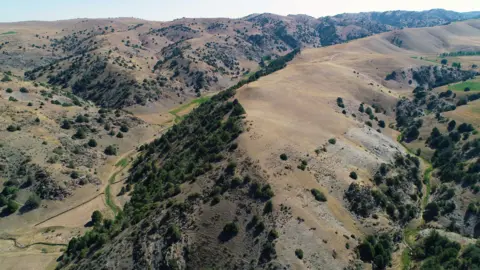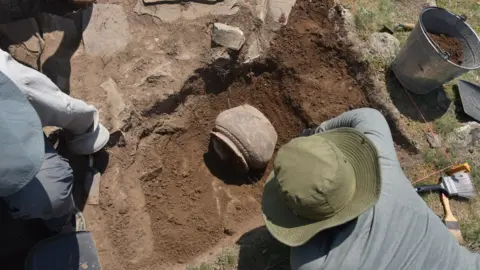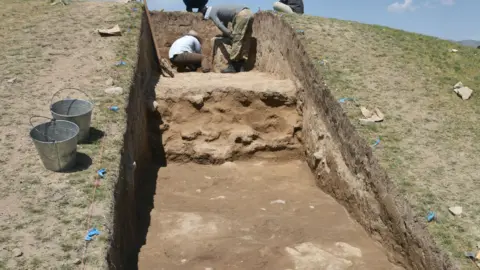 Michael Frachetti
Michael FrachettiArchaeologists have found the remains of two medieval cities in the grassy mountains of eastern Uzbekistan, a discovery that could shift our understanding of the fabled Silk Road.
Known for the exchange of goods and ideas between the East and West, the trade routes were long believed to have linked lowland cities.
But using remote sensing technology, archeologists have now found at least two highland cities that sat along a key crossroad of the trade routes.
One of the cities – Tugunbulak, a metropolis spanning at least 120 hectares – sat more than 2,000m (6,600 ft) above sea level, an altitude thought to be inhospitable even today.
“The history of Central Asia is now changing with this finding,” said archaeologist Farhod Maksudov, who was part of the research team.
The team believes Tugunbulak and the smaller city, Tashbulak, were bustling settlements between the 8th and 11th centuries, during the Middle Ages, when the area was controlled by a powerful Turkic dynasty.
Only 3% of the world’s population live above this altitude today. Lhasa in Tibet and Cusco in Peru are among the rare examples.
The discovery led by Mr Maksudov, director of Uzbekistan’s National Center of Archaeology and Michael Frachetti, an archaeologist at Washington University in St Louis, was made possible with drones and a remote-sensing tool known as lidar, which uses reflected light to create three-dimensional mappings of the environment.
Their research was published in the scientific journal Nature this week, and experts who are not involved in it have hailed its significance in shedding light on the lifestyles of nomadic communities.
 Michael Frachetti
Michael FrachettiThe team first discovered Tashbulak, the smaller city, in 2011 while trekking in the mountains. They found burial sites, thousands of pottery shards and other signs that the territory was populated.
Historical records allude to cities in the region, he said, but the team did not expect to find a 12-hectare medieval city some 2,200m above sea level.
“We were kind of blown away,” Mr Frachetti told the BBC.
Even trekking up there was rough, he added, as they encountered strong winds, storms and logistical challenges.
Four years later, a local forestry administrator tipped off the team to study another site close to Tashbulak.
“The official said, ‘I think I have some of those kinds of ceramics in my backyard.’
“So we went to his house… And discovered his house was built on a medieval citadel. He was like living on a huge city,” Mr Frachetti said.
The most challenging part in these discoveries was in convincing the academic community that these cities existed.
“We would say to people that we found this amazing site, and we would get scepticism, that maybe it’s not so big, or it’s just a mound, or a castle… That was the big challenge, how to document this city scientifically to actually illustrate what it was,” Mr Frachetti said.
 Michael Frachetti
Michael FrachettiIn 2022, the team returned with a drone equipped with a lidar sensor, which helped peel back the surfaces to unveil walls, guard towers, intricate architectural features and other fortifications in Tugunbulak.
The researchers suggest that communities may have chosen to settle in Tugunbulak and Tashbulak to tap strong winds to fuel fires needed to smelt iron ores – which the region was rich in. Preliminary excavations have also uncovered production kilns.
“Whoever had iron in their hands in medieval time was very powerful,” Mr Maksudov said.
But this could also have led to the communities’ downfall, he said. This area used to be covered by a thick juniper forest, but these could have been cut to facilitate iron production. “The area became environmentally very unstable because of the flash floods, because of the avalanches,” he said.
Typically, scholars have expected to find evidence of settlements lower down in the valley, “so these finds are remarkable”, said Peter Frankopan, a global history professor at Oxford University.
“What an amazing treasure trove… that shows the deep interconnections criss-crossing Asia, as well as the links between exploitation of natural resources more than a millennium ago,” he said.
High-altitude urban sites are “extraordinarily rare” in the archaeological record because communities face unique challenges in settling there, said Zachary Silvia, an archaeologist at Brown University.
The team’s work provides an “immense contribution to the study of medieval urbanism in Central Asia”, he wrote in a commentary on Nature.

